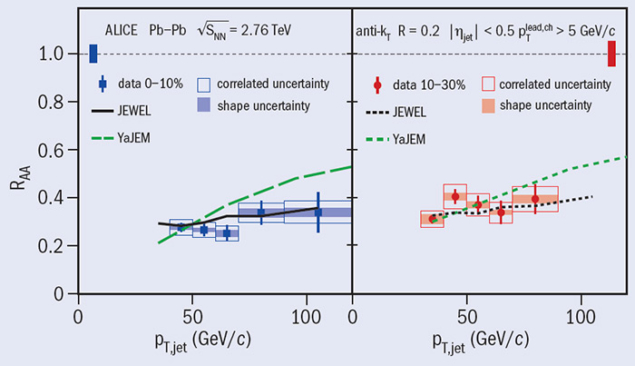
In high-energy collisions at the LHC, quarks and gluons occasionally scatter violently and produce correlated showers of particles, or “jets”. In proton–proton collisions, the rate of such scatters is precisely calculable using perturbative QCD. However, in heavy-ion collisions, jets should be modified, because the scattered quarks and gluons are expected to interact with the surrounding hot nuclear matter, the quark–gluon plasma (QGP). Jet measurements, together with model calculations of the “jet quenching” phenomenon, therefore provide important information about the properties of the QGP.
Fully reconstructed jets are measured in ALICE by high-precision tracking of charged particles in the central barrel, and by measuring the energy deposits of neutral particles in the electromagnetic calorimeter. This method of reconstructing jets differs from the more traditional approach with hadronic and electromagnetic calorimetry. It was first applied in ALICE to determine the production rate for jets in the case of proton–proton collisions (CERN Courier May 2013 p31). In heavy-ion collisions, measurements of jets are more challenging, because a single event contains multiple jets from independent nucleon–nucleon scatters, as well as combinatorial jets from the large and partially correlated underlying background of particles with low transverse momentum (pT).

ALICE has recently published results from the 2011 lead–lead (Pb–Pb) run, down to low jet pT, where jet quenching is expected to be most dramatic. Jets were reconstructed using the anti-kT algorithm with a resolution parameter of R = 0.2. Even for this rather small cone size, the average contribution of the background was measured to be 25±5 GeV/c in the 0–10% most central (highest multiplicity) Pb–Pb events. To deal with the background, the analysis first subtracted the average contribution in a given event jet-by-jet, and then corrected the resulting reconstructed jet spectrum for the background fluctuations and instrumental resolution via an unfolding procedure. This led to an overall systematic uncertainty of about 15–20%.
The nuclear modification of the jet yield (RAA) is quantified by the ratio of the jet spectrum measured in Pb–Pb to that in proton–proton collisions scaled by the number of independent nucleon–nucleon collisions. The figure shows RAA for the 0–10% and 10–30% most central Pb–Pb collisions, together with the two model calculations. It reveals that the jets in Pb–Pb are suppressed strongly, almost independent of jet pT, with an average nuclear modification factor of 0.28±0.04 in 0–10% and 0.35±0.04 in 10–30% of Pb–Pb collisions. Both model calculations were able to predict the level of jet suppression, while one of them expected a slightly steeper increase with pT than the data. This new measurement, which uses jet constituents down to a few hundred MeV/c, even in Pb–Pb collisions, opens new perspectives for studying the QGP with ALICE.








